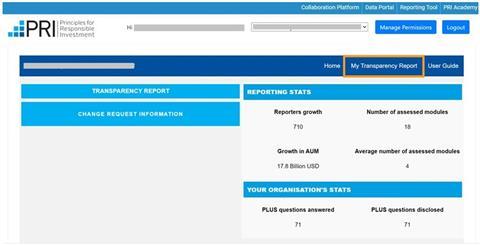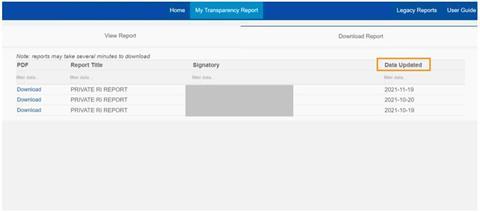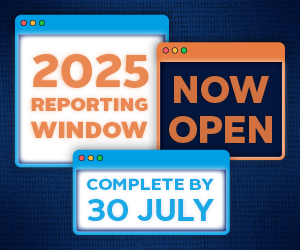The 2021 data collection and review period is over, and accepted changes requested by signatories have been implemented in the Reporting Tool. The amended 2021 Transparency Reports have been re-uploaded privately onto the Data Portal. Although we have significant internal checks in place to ensure amendments have been made accurately, signatories have until 28 March, 10 a.m. GMT to flag potential concerns with the amendments made before PRI finalises the 2021 reporting dataset.
1. Access the Data Portal
Signatories need to log in to the Data Portal to view their 2021 amended private Transparency Reports. If needed, you can reset your passwords here.
Main admins and admins of signatory organisations are already set up to access the Data Portal using their existing PRI credentials (your email and PRI password).
Contributors may not have access to the Data Portal even if they have access to the Reporting Tool. Contributors of signatory organisations must request access from their main admin or admin to gain access to the Data Portal.
New users, i.e., signatory contacts that have not registered for PRI platforms, can gain access to the Data Portal by:
- Registering for a PRI account on behalf of their signatory organisation here then,
- contacting their main admin or admin requesting access to the Data Portal. Main admins and admins should follow the below steps to give new users access.
Main admins and admins can add contributors to the Data Portal by:
- Accessing the permission system here;
- Selecting the ‘Users/Roles’ tab;
- Ticking the ‘Data Portal contributor’ box next to a user’s name if they are already in the system; or
- Selecting ‘Invite User(s)’ to add the new user if they are not already in the system.
- Please see the PRI’s brief permissions system guide for more information.
Should you experience an issue with how the Data Portal is displayed in your browser, please follow the below steps:
- Perform a hard refresh of the page:
- Chrome, Firefox or Edge for Windows: Press Ctrl+F5, Shift+F5 and/or Ctrl+Shift+R
- Chrome or Firefox for Mac: Press Shift+Command+R
- Clear you cache and cookies. Please see the instructions for your specific browser: Google Chrome, Firefox, Microsoft Edge or Safari.
2. Download your private Transparency Report from the Data Portal
In the Data Portal, signatories can view their report in the “My Transparency Report” section. This is accessed via the homepage of the Data Portal.

Download your Transparency Report using the “Download Public and Private Report (PDF)” or “Download Public and Private Data (CSV)” buttons. You need to download the private version of your Transparency Report as this will include all the indicators in your report.

The “Download Public and Private Data (PDF)” button will take you to the “Download Report” tab. Under the “Download Report tab,” please download the version of your report with the latest “data updated” date to view your amended report.

See the Data Portal guide for more information on how to access your Transparency Report.
3. Contact the PRI if you have questions or concerns about your amended 2021 report.
Although we have significant internal checks in place to ensure amendments following the data collection process have been made accurately, signatories have until 28 March, 10 a.m. GMT to flag any potential concerns with the amendments made before we finalise the 2021 dataset.
If an amendment to your private Transparency Report has been made incorrectly on your behalf, please contact us at [email protected], by 28 March, 10 a.m. GMT. You should expect to receive a confirmation email within 2 business days.
Amended reports policy
During the two-week period in March, signatories may flag concerns with their amended 2021 private Transparency Reports.
This includes:
- amendments to 2021 reports, based on accepted changes from October/November 2021, if made incorrectly by the PRI on the signatory’s behalf;
- formatting or display issues with 2021 reports in the Data Portal.
This does not include:
- new change requests to the previously identified data gaps or indicator issues that a signatory did not respond to in October/November 2021;
- ad hoc change requests not based on identified data gaps or indicators from October/November 2021. Examples include:
- minimum requirement indicators for Investors for reasons other than a Reporting Tool error.
- human error or misreporting.
- forgetting to save an answer.
- spelling/grammar mistakes.
- out of date links.
- the data was not available before the reporting deadline.
- the answer refers to a new process.
- something you are doing now which you were not doing before submitting the data.
- senior leadership statement edits.
- changes to feedback boxes, including those that were, incorrectly, used by signatories as additional comment boxes.
- public and/or private disclosure settings on an indicator level.
Support
If you have questions about your amended report, please contact us at [email protected]. We intend to respond to queries within two business days.
FAQs
Data Collection Process
Reviewing your report and requesting changes to address potential data errors was optional. We allowed signatories four weeks to review their reports and request changes. If signatories did not request any changes within this four-week window, their assessment will be based on the data submitted to the PRI during the 2021 reporting cycle.
The PRI has followed up with signatories where further changes were required or if we needed clarification. The changes have been implemented, and we have now re-uploaded signatories’ amended private Transparency Reports onto the Data Portal. All signatories can view their amended 2021 private Transparency Reports in the Data Portal.
We have re-uploaded signatories’ amended Transparency Reports in the Data Portal. If the changes you requested have not been correctly implemented, please contact us at [email protected] by 28 March, 10 a.m. GMT. Once you have submitted your request to [email protected] you should expect a confirmation email within two business days.
While you can download parts of your Transparency Report that have been made ‘public’ in the Data Portal, the PRI is not launching 2021 public Transparency Reports until June 2022.
Outputs
We are releasing the 2021 reporting outputs in stages, with Transparency Reports released first in the new Data Portal. We aim to release the public Transparency Reports (for investors and service providers) and the private Assessment Reports (only for investors) in June 2022, alongside an updated assessment methodology.
Unfortunately, it will not be possible to receive your Assessment Report early. Signatories’ Assessment Reports will not be available in the Data Portal until signatories have had a chance to flag potential concerns with their amended reports, and the Assessment Reports generated. The PRI intends to release Assessment Reports in June 2022.
The Assessment Reports will be based on the amended private Transparency Report. In instances where signatories did not request changes to their reports in 2021 where missing data were identified, the assessment will be based on the data submitted to the PRI during the 2021 reporting cycle, and no accommodation can be made for outstanding data errors.
Your reports from 2020 and previous years can be found in the Data Portal, under the “Legacy Reports” tab. The public versions of your previous Transparency Reports are also available here.
Fees
The PRI will ensure fees are maintained at their current (2021) level for the coming calendar year. This nominal maintenance of fees at their current level constitutes a reduction of fees in real terms. The PRI offers value to signatories in a number of areas beyond the reporting function, including thought leadership, tools for investors, guidance on ESG integration by asset class, thematic work and more, alongside our global events schedule. As the PRI is a membership organisation, any reduction in fees will have a direct impact on the level of service that it’s possible for the PRI to provide to signatories across these wider areas.
Signatory Renewal fees have previously been calculated on Reported Gross AUM. As there will be no reporting in 2022 the renewal fees will be calculated on 2021 reported Gross AUMs. The board have also agreed that going forward all renewal fees will be based on the previous years reported Gross AUM.







